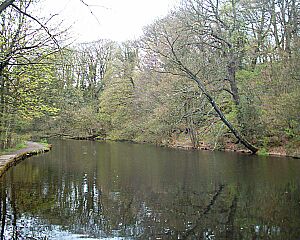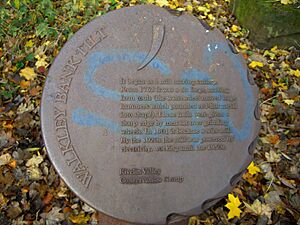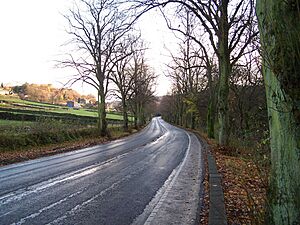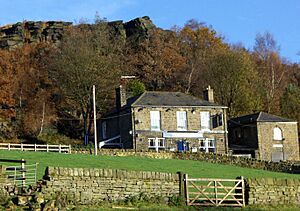River Rivelin facts for kids
Quick facts for kids River Rivelin |
|
|---|---|
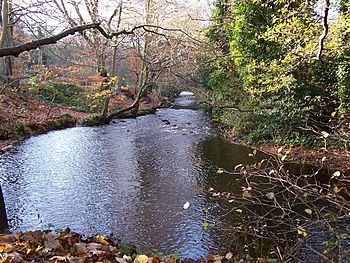
The river at the site of Walkley Bank Tilt.
|
|
| Country | England |
| Physical characteristics | |
| Main source | Pennines |
| Length | 8 miles (13 km) |
The River Rivelin is a river found in Sheffield, South Yorkshire, England. It starts high up on the Hallam moors in north-west Sheffield. The river then flows into the River Loxley near Malin Bridge.
The Rivelin Valley is a beautiful woodland area that stretches for about 5.6 kilometers (3.5 miles) along the river. It's home to the popular Rivelin Valley Nature Trail, which was created in 1967. The valley also has farmland on its gentler slopes higher up.
The River Rivelin flows quite fast, dropping 80 meters between Rivelin Mill Bridge and Malin Bridge. It gets a steady supply of water from the nearby moorland peat. For hundreds of years, people used the river's strong flow to power water wheels. These wheels helped run up to twenty different industries, like forges (where metal is shaped), metal-working shops, and flour mills, all along the river's path.
Contents
History of the Rivelin Valley
Ancient Times
There's proof that Romans lived in the Rivelin Valley area a long time ago. In 1761, special stone tablets were found on the Stannington side of the valley. These tablets showed that land was given to Roman soldiers from the Sunuci tribe who were retiring. Other Roman items have also been found on Walkley Bank Road, which leads to a ridge facing Stannington.
Medieval Hunting Grounds
During the Middle Ages, the Rivelin Valley was a huge area set aside for deer hunting by the Lords of Hallamshire. It was called Rivelin Chase or Firth. This hunting ground covered thousands of acres on the western hills outside of Sheffield.
In 1637, a survey by John Harrison found that the Firth was about 6,863 acres (2,778 hectares) big. Most of this land was within Sheffield Parish. Until the 1900s, the River Rivelin marked the north-western edge of Sheffield.
Industrial Past and Water Mills
The Rivelin Valley has 21 man-made ponds. These ponds are proof of the twenty mills that once used the river's power. Most of the old mills and forges are gone now. However, the ponds that fed them are still there, thanks to the help of the Rivelin Valley Conservation Group (RVCG) and Yorkshire Water.
Here are some of the most well-known mills, listed from west to east:
Rivelin Corn Mill
This was the mill furthest to the west, located at the bottom of Rails Road. It dates back to the 1600s and was owned by Gilbert Talbot, 7th Earl of Shrewsbury. By 1830, it had two waterwheels that powered three grinding stones for flour. However, sometimes there wasn't enough water in the summer, so the mill couldn't always work at full power.
The mill kept running until the 1930s. After that, the buildings quickly fell apart and were taken down in the early 1950s. Now, a small car park is on the site. The dam wall was damaged in 1967 and finally collapsed in 2001. The RVCG and Sheffield Council then filled in the old pond and made a new one nearby, with a platform for pond dipping. It officially opened in May 2007.
Wolf Wheel
The Wolf Wheel was built around 1722. It had one of the biggest waterwheels in the valley, measuring 15 feet (4.6 meters) across. The Windle brothers owned it from 1818 to 1852 and used it to grind knives and razors. Later, it was sold to the Water Company.
The mill was used regularly until 1918. By 1934, its inside machinery had been taken apart. The pond that supplied the Wolf Wheel is still in great shape and has been cared for by the RVCG. It's one of four dams in the valley used by fishermen. You can also see wildlife like dragonflies (such as the common darter and common hawker), kingfishers, great diving beetles, and amphibians like common frogs and palmate newts.
Hind Wheel Mill
This is the oldest mill in the valley, first recorded in 1581. Thomas Hind, Robert Webster, and John Swynden were the owners, paying £1 rent each year. The mill was completely rebuilt around 1820 and stopped working around 1930. By 1936, the building had completely disappeared.
The Round Pond, which served this mill, is one of the most popular in the area. It's stocked with trout for people who like to fish. The area around it has lots of different wildlife and a picnic spot.
Nether Cut Wheel
Located near the "S" bend on the A6101 road, the Nether Cut was the last mill to operate in the valley. It was still grinding scythes (long curved blades for cutting grass) until 1939. The mill was not taken down until 1956.
The mill had some problems and damage during the Sheffield Outrages in 1874. This was due to disagreements over using workers who were not part of a union.
Walkley Bank Tilt
This started as a mill making cutlery around 1750. From 1762, it became a tilt forge, which made farming tools. In 1901, it changed into a wire mill. In the 1920s, it started using electricity for power. It was one of the last mills in the valley to close, still working in the 1950s.
The area around the dam has been improved for people to enjoy. It now has a small car park and benches. The dam is popular with fishermen and has many waterfowl (birds that live on water).
Mousehole Forge
This forge is near Malin Bridge and dates back to 1628. It was known for making iron and metal bars. However, the forge became famous worldwide for making anvils (heavy iron blocks used by blacksmiths). These anvils were highly praised and won a gold medal at The Great Exhibition in 1851. It's even said that the famous anvil at Gretna Green was made by Mousehole Forge. Production stopped in 1933, and part of the forge is now a private house.
Grogham Wheel
This was the very last mill in the valley before the Rivelin joins the River Loxley. It had two waterwheels, and the biggest one, called "Groggy," was the largest in the entire valley. This mill ground files and cutlery. It was the only mill in the valley that was damaged by the Great Sheffield Flood because water backed up the valley. The mill stopped making things in 1933, and its buildings were taken down in 1935 for safety reasons.
Wildlife in the Valley
The Rivelin river valley is home to many different animals. You can see birds like mallards, dippers, kingfishers, long-tailed tits, grey herons, and wrens.
At the Fox Hagg nature reserve on the south side of the river, you might spot meadow and tree pipits, redstarts, linnets, and several types of warblers.
Rivelin Valley Road
Rivelin Valley Road was built in 1907. It connects Malin Bridge to Rivelin Mill Bridge, linking up with the main road from Sheffield to Manchester (now the A57). Before this road, the valley only had small tracks connecting the mills.
The local water board, who owned the land, suggested building the road in 1905. The Duke of Norfolk also gave 4.5 hectares (11 acres) of his land for the project. Work began in November 1905 and gave jobs to 176 unemployed men. There were many people out of work at the time, so providing jobs was a big reason for building the road.
Materials for the road came from Clough Field quarry, located on the southern slopes of the valley below Crosspool. Over 700 lime trees were bought in 1906 for £147. These lime trees were planted along 3.5 miles (5.6 kilometers) of the road, making it the second longest lime tree avenue in Britain. The road opened on September 1, 1907, though work finished in June 1908. The total cost was £30,000. Local people quickly called it "The New Road," a name used for many years.
Because the project successfully provided jobs, Sheffield Corporation decided to go ahead with plans to connect the new road to the Sheffield suburbs of Crookes and Walkley. Rivelin Valley Road is now known as the A6101.
The valley was especially loved by a poet named Ebenezer Elliott, who was known as the "corn law rhymer." There's a rock by Black Brook with his name carved on it, where he often sat to enjoy nature. Elliott wrote a lyrical poem called "Farewell To Rivelin" about the valley. Some lines from it are:
- Beautiful river! goldenly shining,
- Where, with the cistus, woodbines are twining,
- Birklands around thee, mountains above thee,
- Rivelin wildest! Do I not love thee.
Valley Landmarks
Besides its industrial history, the valley has lots of wildlife, which is now protected by the Rivelin Valley Conservation Group. The upper part of the valley has Rivelin Rocks to the north. These rocks appear again about 3 kilometers (2 miles) further down the valley, above the Rivelin Hotel on Tofts Lane.
Behind the hotel is the Man's Head Rock. This was once a very famous rock formation shown on many postcards, but now it's hidden by tall trees. The Rivelin Hotel is the only public house (pub) in the rural part of the valley. It used to be farm buildings before it was turned into a pub. Another pub, the Holly Bush, is further down the valley, closer to Malin Bridge.
One of the most important buildings in the valley is the former King Edward VII Hospital. This building is protected as a Grade II listed building. The hospital closed in 1992 and has now been turned into apartments.
St Michael's Cemetery, a Catholic burial ground, is located at the Malin Bridge end of the valley. Across the road from St. Michael's is the Rivelin Valley Park. This is a small public recreation area with a cafe, a playground, and the Rivelin splash pools. The splash pools opened in July 2013, replacing older paddling pools.
Proposed Flood Protection Plan
In September 2014, Sheffield City Council announced plans to build a dam wall in the valley. They looked at two possible places: the Swallow/Wolf flood storage area or the Roscoe/New Dam flood storage area. After asking the public for their thoughts, the plans for the Swallow/Wolf area were dropped. However, the Roscoe/New Dam area is still an option.
If built, the dam would be over 11 meters (36 feet) high with a 4-meter (13-foot) wide top. This project aims to reduce the water depth downstream by 1.5 meters (5 feet) during very heavy rain. This would help prevent floods like those that happened in 2007 United Kingdom floods, which flooded parts of the city.
This plan could be very debated if it goes forward. The area where water would be held might cover and damage old and special structures that are part of Sheffield's industrial history. It could also flood allotment gardens (small plots of land rented for growing food). The river's path would need to be changed, and the nature trail area might be covered by the dam's embankment. A concrete tunnel, called a culvert, for the river might need to be as long as 70 meters (230 feet).
There's also discussion about how much the Rivelin contributed to the 2007 floods. So, the numbers for this plan will be carefully checked by the public, who are very concerned. In a council survey, 60% of people who shared their opinion were against this plan. It was the least popular option the council suggested.
Artists and the Rivelin Valley
In the 1920s, a group of artists created a special place in the Rivelin Valley. They included Ben Baines, W R E Goodrich, Robert Scott-Temple, and Vernon Edmonds. Many other artists also worked in the Rivelin area, finding inspiration in its beauty.
- W. J. Stevenson (1835–1905) painted the inside of Spooner's Wheel in 1877.
- W. E. Smith painted the valley from a spot called Bell Hagg around 1966.
- Joseph Hallam Hawkesworth (1827–1908) painted the river.
- G. Hattersley Pearson (1858–1937) painted Roscoe Wheel around 1890.
- Christopher Thomson (1799–1871) painted the Rivelin, near where the Black Brook joins it, around 1860.
- Joseph Wrightson MacIntyre (1842–1897) painted the inside of Holme Head Wheel in 1879.


